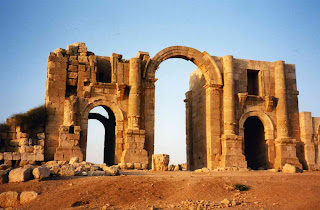Jerash, the Gerasa of Antiquity, is the capital and largest city of Jerash Governorate (محافظة جرش), which is situated in the north of Jordan, 48 kilometres north of the capital Amman
towards Syria. Jerash Governorate's geographical features vary from
cold mountains to fertile valleys from 250 to 300 metres
above sea level, suitable for growing a wide variety of crops.A strong earthquake in 749 AD destroyed large parts of Jerash, while
subsequent earthquakes along with the wars and turmoil contributed to
additional destruction. Its destruction and ruins remained buried in the
soil for hundreds of years until they were discovered by German Orientalist Ulrich Jasper Seetzen in 1806 to begin excavation and to return life to rise to the current Jerash by
inhabitants of old villages. Then followed 70 years after by the
community of Muslims, Circassians, who emigrated to Jordan from the Caucasus in 1878 after the Ottoman-Russian war. And a large community of people of Syria at the beginning of the 20th century
Jerash has developed dramatically in the last century and the growing importance of the tourism industry to the city. Jerash is now the second-most popular tourist attraction in Jordan, closely behind the splendid ruins of Petra The ruins have been carefully preserved and spared from encroachment, with the modern city sprawling to the west of ancient Jerash's city walls.
 In addition to inhabitants of old villages, Jerash became a
destination for many successive waves of foreign migrants. The first
wave started during the first half of the 20th century when the Syrians (Shwam) and the Circassians
camped nearby the old ruins. The new immigrants have been welcomed by
the local people and settled down in the city. Later, Jerash also
witnessed waves of Palestinian refugees who flow to the city in 1948 and
1967.
In addition to inhabitants of old villages, Jerash became a
destination for many successive waves of foreign migrants. The first
wave started during the first half of the 20th century when the Syrians (Shwam) and the Circassians
camped nearby the old ruins. The new immigrants have been welcomed by
the local people and settled down in the city. Later, Jerash also
witnessed waves of Palestinian refugees who flow to the city in 1948 and
1967. However, recently the city of Jerash has been expanded to include many of the surrounding villages including Souf,
Dairelliat, Thougretasfour, Jaba, Aljbarat and Majar. Other important
villages in the governorate include: Kitteh, Sakib, Nahlé, Burma,
Mustabah, Jubba, Raimoun, KufrKhall, Balila, and Qafqafa.
However, recently the city of Jerash has been expanded to include many of the surrounding villages including Souf,
Dairelliat, Thougretasfour, Jaba, Aljbarat and Majar. Other important
villages in the governorate include: Kitteh, Sakib, Nahlé, Burma,
Mustabah, Jubba, Raimoun, KufrKhall, Balila, and Qafqafa.
Since 1981, the old city of Jerash has hosted the Jerash festival,
a three week long summer program of dance, music, and theatrical
performances. The festival is frequently attended by members of the
royal family of Jordan and is hailed as one of the largest cultural
activities in the region.
In addition performances of the Roman Army and Chariot Experience
(RACE) were started at the hippodrome in Jerash. It
features forty-five legionaries in full armour in a display of Roman
Army drill and battle tactics, ten gladiators fighting “to the death”
and several Roman chariots competing in a classical seven lap race
around the ancient hippodrome.
Jerash se encuentra en el norte de Jordania, a 48
kilómetros al norte de la capital. Las características
geográficas de Jerash varían desde las frías montañas a los valles
fértiles a 250-300 metros sobre el nivel del mar, apto para el cultivo
de una amplia variedad de cultivos.
Un
fuerte terremoto en el año 749 dC destruyó gran parte de Jerash, y las guerras y disturbios posteriores contribuyeron a una destrucción adicional. Las ruinas permanecieron enterradas en el suelo durante
cientos de años hasta que fueron descubiertos por el alemán Ulrich
Jasper orientalista Seetzen en 1806 quien comenzó una excavación para
devolver a la vida la actual Jerash.
Jerash ha desarrollado en el último siglo una creciente industria turística haciendo de ella la segunda atracción turística más popular en Jordania, cerca de las espléndidas ruinas de Petra.
Además de los habitantes de los pueblos antiguos, Jerash se convirtió en un destino para oleadas de inmigrantes extranjeros. La primera ola se inició durante la primera mitad del siglo 20, cuando los sirios (Shwam) y circasianos acamparon cerca de las ruinas antiguas. Los nuevos inmigrantes fueron bien recibidos por la población local y se establecieron en la ciudad. Más tarde, Jerash también fue testigo de oleadas de refugiados palestinos que fluyen a la ciudad en 1948 y 1967.Desde 1981, la antigua ciudad de Jerash ha sido sede del Festival de Jerash, un programa de tres semanas de verano de danza, música y representaciones teatrales. El festival es muy frecuentado por los miembros de la familia real de Jordania y es aclamado como uno de los más grandes de actividades culturales en la región.
El festival cuenta
con cuarenta y cinco legionarios con armadura completa, diez gladiadores que luchan
"hasta la muerte" y varias cuadrigas romanas que compiten en una
clásica carrera de siete vueltas por el antiguo hipódromo.



No comments:
Post a Comment